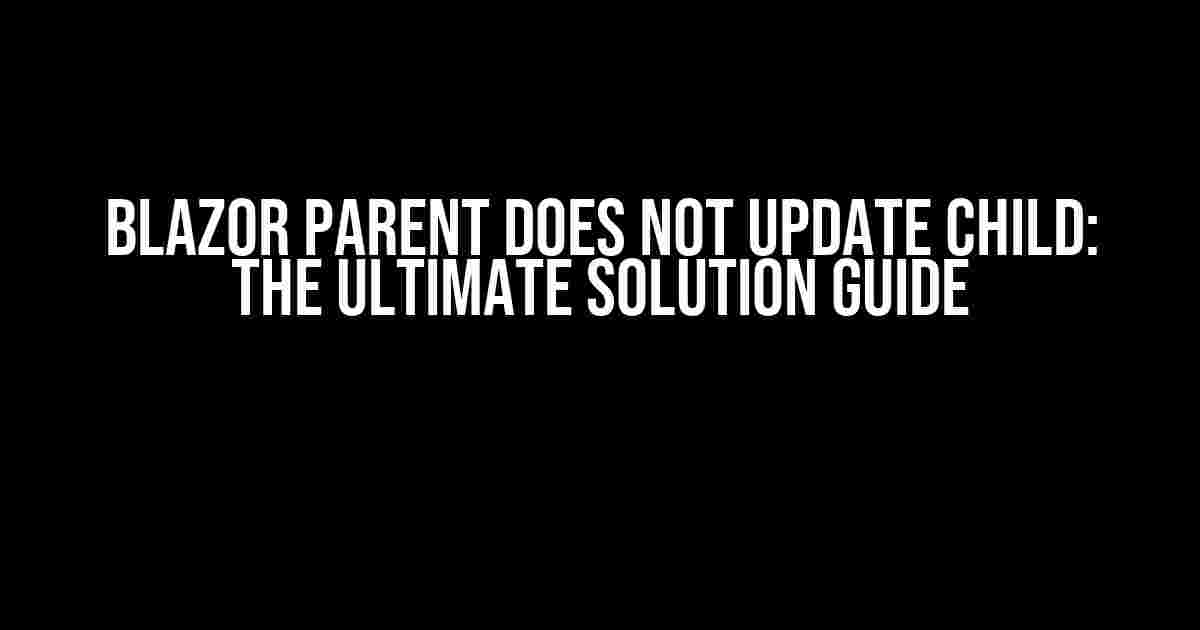Are you tired of dealing with the frustration of a Blazor parent component not updating its child component? You’re not alone! This issue is a common pitfall that many Blazor developers face. But fear not, dear reader, for we have the solution to this conundrum right here.
Understanding the Problem
Before we dive into the solution, let’s take a step back and understand why this issue occurs in the first place. In Blazor, components are rendered based on their state. When the state of a parent component changes, its child components should ideally re-render to reflect the new state. But sometimes, this doesn’t happen. The parent component updates, but the child component remains stuck in its original state.
Cause of the Problem
There are several reasons why a Blazor parent component might not update its child component. Some common causes include:
- Improper use of the `StateHasChanged` method
- Incorrect implementation of the `ShouldRender` method
- Failure to notify the child component of state changes
- Incorrect use of the `asp-prerender-module` attribute
Solving the Problem
Now that we understand the causes of the problem, let’s dive into the solutions. We’ll provide you with step-by-step instructions to ensure that your Blazor parent component updates its child component correctly.
Solution 1: Using StateHasChanged Correctly
The `StateHasChanged` method is used to notify the component that its state has changed and it should re-render. To use this method correctly:
- Create a private field in your parent component to track the state change
- Update the state field when the parent component’s state changes
- Call the `StateHasChanged` method after updating the state field
@code {
private bool _hasChanged;
protected override void OnParametersSet()
{
_hasChanged = true;
StateHasChanged();
}
}
Solution 2: Implementing ShouldRender Correctly
The `ShouldRender` method determines whether the component should re-render based on its state. To implement this method correctly:
- Override the `ShouldRender` method in your parent component
- Return `true` if the component’s state has changed
- Return `false` if the component’s state has not changed
@code {
protected override bool ShouldRender()
{
return _hasChanged;
}
}
Solution 3: Notifying the Child Component
To notify the child component of state changes, you can use the `Parameter` attribute to pass the updated state as a parameter.
@page "/"@code { private bool _myState = true; protected override void OnParametersSet() { _myState = !_myState; } } @code { [Parameter] public bool MyState { get; set; } }
Solution 4: Using asp-prerender-module Correctly
The `asp-prerender-module` attribute is used to enable prerendering of components. To use this attribute correctly:
<app>
@(await Html.RenderStaticComponent<App>(parameters))
</app>
@code {
[Host]
public string? ServerPrerendered { get; set; }
}
Additional Tips and Tricks
In addition to the solutions provided above, here are some additional tips and tricks to ensure that your Blazor parent component updates its child component correctly:
- Use the `debug` attribute to debug your component and identify the issue
- Use the `RenderMode` attribute to specify the render mode of your component
- Avoid using `async` methods in your component’s lifecycle methods
- Use the `ComponentBase` class to create a base class for your components
Conclusion
There you have it, folks! With these solutions and tips, you should be able to resolve the issue of a Blazor parent component not updating its child component. Remember to use the `StateHasChanged` method correctly, implement the `ShouldRender` method correctly, notify the child component of state changes, and use the `asp-prerender-module` attribute correctly. By following these steps, you’ll be well on your way to creating robust and efficient Blazor applications.
Frequently Asked Questions
We’ve answered some of the most common questions related to this topic to help you further.
| Question | Answer |
|---|---|
| Why does my Blazor parent component not update its child component? | This can occur due to improper use of the `StateHasChanged` method, incorrect implementation of the `ShouldRender` method, failure to notify the child component of state changes, or incorrect use of the `asp-prerender-module` attribute. |
| How do I notify the child component of state changes? | You can notify the child component of state changes by using the `Parameter` attribute to pass the updated state as a parameter. |
| What is the purpose of the `ShouldRender` method? | The `ShouldRender` method determines whether the component should re-render based on its state. |
We hope this article has been informative and helpful in resolving the issue of a Blazor parent component not updating its child component. If you have any further questions or concerns, please don’t hesitate to ask.
Here are 5 Questions and Answers about “Blazor parent does not update child” in a creative voice and tone:
Frequently Asked Question
Stuck with a Blazor parent-child conundrum? Don’t worry, we’ve got you covered! Here are some FAQs to help you troubleshoot and resolve the issue.
Q1: Why does my Blazor parent component not update my child component?
This could be due to a lack of state change notification. Make sure you’re using a two-way binding mechanism, such as `@bind`, to notify the parent component of changes to the child component’s state. Alternatively, use a state container like Redux or Flux to manage your application’s state.
Q2: I’ve tried using `@bind` but my child component still doesn’t update. What’s going on?
Check if your child component is properly registered in the parent component’s markup. Also, ensure that the `@bind` syntax is correct and that the property being bound is a valid, publicly accessible property on the child component.
Q3: What if I’m using a third-party library and the child component doesn’t expose a bindable property?
In this case, you might need to create a wrapper component around the third-party component and implement the necessary state change notification mechanisms. This will allow you to integrate the third-party component with your Blazor application’s state management.
Q4: How do I debug a parent-child update issue in a Blazor application?
Use the browser dev tools to inspect the component tree and verify that the child component is properly registered and updated. You can also add diagnostic logging or breakpoints in your code to track state changes and identify potential issues.
Q5: Are there any performance implications to consider when updating child components in Blazor?
Yes, excessive or unnecessary updates to child components can impact performance. To mitigate this, use techniques like memoization, caching, or optimizing your state change detection mechanisms to minimize unnecessary updates.
I hope these questions and answers help you resolve your Blazor parent-child conundrum!


